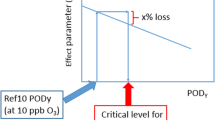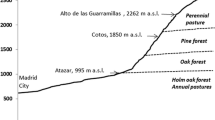Abstract
The United States is making the transition from the 1979 1 hr maximum ozone standard to the newly adopted 8 hr ozone standard (3 yr average of the 4th highest maximum 8 hr ozone concentration). Consequently, we analyzed and compared ozone concentrations under both standards from a variety of monitoring sites throughout the central Appalachianregion of Kentucky (KY), West Virginia (WV), and Virginia (VA). Data from 1988–1999 were used to determine how ozone exposure between the two metrics compared for remote sites. Most sites exceeded the 1 hr standard in 1988–1990 due to the 3 yr averaging and multiple high ozone concentrations that occurred over the region in 1988. All sites were in compliance with the 1 hr standard every year after 1991. It was much more common for the ozone exposure to exceed the 8 hr standard, particularly from 1997–1999. Many sites showed exceedences beginning in 1995; Big Meadows (VA) exceeded the 8 hr standard all years except 1994 and 1996. Response of vegetation to ozone in these areas was determined using the combination of W126 values (sigmoidally weighted exposure index), the number of hours that average concentrations ≥0.10 ppm (N100), and the presence of moderate or more extreme droughts. In general, W126 and N100 values suggested that negative vegetation growth responses over most of the 12 yr would have been minimal for most sites, even for those exceeding ozone standards. Drought-induced stomatal closures would have overridden more extreme negative growth responses at all but the Big Meadows site in 1988.
Similar content being viewed by others
References
Baumgardner, R. E. and Edgerton, E. S.: 1998, ‘Rural ozone across the eastern United States: Analysis of CASTNet data, 1988–1995’, J. Air Waste Manage. Assoc. 48, 674–688.
Bennett, J. P., Rassat, P., Berrang, P. and Karnosky, D. F.: 1992, ‘Relationships between leaf anatomy and ozone sensitivity of Fraxinus pennsylvanicaMarsh. and Prunus serotinaEhrh.’, Environ. Exper. Biol. 32, 33–41.
Berrang, P., Karnosky, D. F., Mickler, R. A. and Bennett, J. P.: 1986, ‘Natural selection for ozone tolerance in Populus tremuloides’, Can. J. For. Res. 16, 1214–1216.
Chappelka, A. H. and Samuelson, L. J.: 1998, ‘Ambient ozone effects on forest trees of the eastern United States: A review’, New Phytologist 139, 91–108.
Coleman, M. D., Isebrands, J. G., Disckson, R. E. and Karnosky, D. F.: 1995, ‘Photosynthetic productivity of aspen clones varying in sensitivity to tropospheric ozone’, Tree Physiol. 15, 585–592.
Edwards, P. J., Wood, F. and Kochenderfer, J. N.: 1991, ‘Characterization of ozone during consecutive drought and wet years at a rural West Virginia site’, J. Air Waste Manage. Assoc. 41, 1450–1453.
Environmental Science and Engineering: 1999, ‘Clean Air Status and Trends Network (CASTNet) 1998’, Annual Report, EPA Contract No. 68-D-98-112, August 1999, EPA Internet Web Site www.epa.gov/acidrain/castnet/annual98/annual98.html.
Flagler, R. B., Spruill, S. E., Chappelka, A. H., Dean, T. J., Kress, L. W. and Reardon, J. C.: 1992, ‘Growth of Three Southern Pine Species as Affected by Acid Rain and Ozone: A Combined Analysis’, in R. B. Flagler (ed.), The Response of Southern Commercial Forests to Air Pollution, Air and Waste Management Assoc., Pittsburgh, PA, U.S.A., pp. 207–224.
Hanson, P. J., Samuelson, L. J., Wullschleger, S. D., Tabberer, T. A. and Edwards, G. S.: 1994, ‘Seasonal patterns of light-saturated photosynthesis and leaf conductance for mature and seedling Quercus rubraL. foliage: Differential sensitivity to ozone exposure’, Tree Physiol. 14, 1351–1366.
Jackson, W. A, Iskra, A. and Edwards, P. J.: 1992, ‘Characterization of Ozone Symptoms on Native Vegetation at the Dolly Sods and Otter Creek Wildernesses’, in R. L. Berglund (ed.), Tropospheric Ozone and the Environment II, Air and Waste Management Assoc., Atlanta, GA, U.S.A., pp. 526–536.
Jones, K. H. and Adler, J.: 1995, ‘Time to reopen the Clean Air Act: Clearing away the regulatory smog’, Policy Analysis No. 233, Cato Institute, Washington, DC, U.S.A.
Kelly, J. M., Samuelson, L., Edwards, G., Hanson, P., Kelting, D., Mays, A. and Wullschleger, S.: 1995, ‘Are seedlings reasonable surrogates for trees? An analysis of ozone impacts on Quercus rubra’, Water, Air, Soil Pollut. 85, 1317–1324.
Lefohn, A. S. and Foley, J. K.: 1992, ‘NCLAN results and their application to the standard-setting process: Protecting vegetation from surface ozone exposure’, J. Air Waste Manage. Assoc. 42, 1046–1052.
Lefohn, A. S., Jackson, W., Shadwick, D. S. and Knudsen, H. P.: 1997, ‘Effect of surface ozone exposures on vegetation grown in the southern Appalachian Mountains: Identification of possible areas of concern’, Atmos. Environ. 31, 1695–1708.
Lefohn, A. S. and Runeckles, V. C.: 1987, ‘Establishing a standard to protect vegetation–ozone exposure/dose considerations’, Atmos. Environ. 21, 561–568.
Lefohn, A. S., Shadwick, D. S. and Mohnen, V. A.: 1990, ‘The characterization of ozone concentrations at a select set of high-elevation sites in the eastern U.S.’, Environ. Pollut. 67, 147–178.
Mussleman, R. C., McCool, P. M. and Lefohn, A. S.: 1994, ‘Ozone descriptors for an air quality standard to protect vegetation’, J. Air Waste Manage. Assoc. 44, 1383–1390.
Ollinger, S. V., Aber, J. D. and Reich, P. B.: 1996, ‘Predicting the Effects of Tropospheric Ozone on Forest Productivity in the Northeastern U.S.’ in Proceedings of the 1995 Meeting of the Northern Global Change Program, U.S. Dept. of Agriculture Forest Service, Radnor, PA, U.S.A., pp. 217–225.
Palmer, W. C.: 1965, ‘Meteorological Drought, U.S. Weather Bureau’, Report No. 45, U.S.Dept. of Commerce, Washington, DC, U.S.A.
Palmer, W. C.: 1967, ‘The Abnormally Dry Weather of 1961–1966 in the Northeastern United States’, in Proceedings of the Conference on Drought in the Northeastern United States, New York Geophysical Research Laboratory Report TR-68-3, pp. 32–56.
Pell, E. J, Temple, P. J., Friend, A. L., Mooney, H. A. and Winner, W. E.: 1994, ‘Compensation as a plant response to ozone and associated stresses–An analysis of ROPIS experiments’, J. Environ. Qual. 23, 429–436.
Peñuelas, J., Ribas, A., Gimeno, B. S. and Filella, I.: 1999, ‘Dependence of ozone biomonitoring on meteorological conditions of different sites in Catalonia (N.E. Spain)’, Environ. Monitor. Assess. 56, 221–224.
SAS Institute: 1988, SAS/STAT User’s Guide, Release 6.03 Edition, SAS Institute Inc., Cary, NC, U.S.A.
Sickles, J. E., II, Suggs, J. C. and Vorburger, L. M.: 2000, ‘Ozone indicators determined at rural sites in the eastern United States by two monitoring networks’, Environ. Monitor. Assess. 65, 485–502.
Soinit, N., Strain, B. R., Hellmers, H., Reichers, G. H. and Jaeger, C. H.: 1985, ‘Long-term atmospheric CO2 enrichment affects the growth and development of Liquidambar styracifluaand Pinus taedaseedlings’, Can. J. For. Res. 15, 468–471.
Southern Appalachian Man and the Biosphere (SAMAB): 1996, ‘The Southern Appalachian Assessment Atmospheric Technical Report’, Report 3 of 5, U.S. Dept. of Agriculture Forest Service, Atlanta, GA, U.S.A.
Southern Appalachian Mountains Initiative: 2002, ‘Southern Appalachian Mountains Initiative’,Final Report, Southern Appalachian Mountain Initiative, Asheville, NC, U.S.A.
Tingey, D. T. and Hogsett, W. E.: 1985, ‘Water stress reduces ozone injury via a stomatal mechanism’, Plant Physiol. 77, 944–947.
Tjoelker, M. G., Volin, J. C., Oleksyn, J. and Reich, P. B.: 1993, ‘Light environment alters response to ozone stress in seedlings of Acer saccharumMarsh. and hybrid PopulusL.’, New Phytologist 124, 627–636.
U.S.D.I. National Park Service: 2003, ‘Assessment of Air Quality and Related Values in Shenandoah National Park’, Technical Report NPS/NERCHAL/NRTR-03/090, U.S. Dept. of Interior National Park Service, Philadelphia, PA, U.S.A.
U.S. Environmental Protection Agency: 1979, Guideline for the Interpretation of Ozone Air Quality Standards, Environmental Protection Agency, Office of Air Quality Planning and Standards, Research Triangle Park, NC, U.S.A., EPA-450/4-79-003.
U.S. Environmental Protection Agency: 1994, Ambient Air Quality Surveillance, Federal Register 40 CFR Part 58, Vol. 59, No. 41628, 12 August 1994.
U.S. Environmental Protection Agency: 1996, Air Quality Criteria for Ozone and Related Photochemical Oxidants, Environmental Protection Agency, Office of Air Quality Planning and Standards, Research Triangle Park, NC, U.S.A., EPA-600/P-93/004bF.
sheets/o3fact.pdf.
U.S. Environmental Protection Agency: 1997b, National Ambient Air Quality Standards for Ozone, Federal Register 40 CFR Part 50, Vol. 62, No. 138, 18 July 1997.
U.S. Environmental Protection Agency: 1997c, National Ambient Air Quality Standards for Ozone: Proposed Response to Remand, Federal Register 40 CFR Part 50, Vol. 66, No. 220, 14 November 1997.
U.S. Environmental Protection Agency: 1998, Guideline on Data Handling Conventions for the 8 hr Ozone NAAQS, Environmental Protection Agency, Office of Air Quality Planning and Standards, Research Triangle Park, NC, U.S.A., EPA-454/R-98-017.
U.S. Environmental Protection Agency: 1999, ‘EPA revokes 1 hr ozone standard for most counties’, Environmental Protection Agency, Office of Air and Radiation, EPA Internet Web Site www.epa.gov/oar/oaqps/greenbk/ozone1hr/may98/o3std.html.
U.S. Environmental Protection Agency: 2002a, ‘Current and revised standards for ozone and particulate matter’, Environmental Protection Agency, Office of Air Quality Planning and Standards, EPA Internet Web Site www.epa.gov/oar/oaqps/ozpmbro/current.html.
U.S. Environmental Protection Agency: 2002b, National Ambient Air Quality Standards (NAAQS), Environmental Protection Agency, Office of Air Quality Planning and Standards, EPA Internet Web Site www.epa.gov/airs/criteria.html.
Weinstein, D. A., Gollands, B. and Retzlaff, W. A.: 2001, ‘The effects of ozone on a lower slope forest of the Great Smoky Mountain National Park: Simulations linking individual tree model to a stand model’, For. Sci. 47, 29–42.
Author information
Authors and Affiliations
Corresponding author
Rights and permissions
About this article
Cite this article
Edwards, P., Huber, C. & Wood, F. Ozone Exposures and Implications for Vegetation in Rural Areas of the Central Appalachian Mountains, U.S.A.. Environ Monit Assess 98, 157–174 (2004). https://doi.org/10.1023/B:EMAS.0000038184.65332.f6
Issue Date:
DOI: https://doi.org/10.1023/B:EMAS.0000038184.65332.f6




